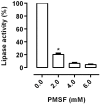Lipase Activity in the Larval Midgut of Rhynchophorus palmarum: Biochemical Characterization and the Effects of Reducing Agents
- PMID: 28902170
- PMCID: PMC5620720
- DOI: 10.3390/insects8030100
Lipase Activity in the Larval Midgut of Rhynchophorus palmarum: Biochemical Characterization and the Effects of Reducing Agents
Abstract
Lipases have key roles in insect lipid acquisition, storage, and mobilization and are also fundamental to many physiological processes in insects. Lipids are an important component of insect diets, where they are hydrolyzed in the midgut lumen, absorbed, and used for the synthesis of complex lipids. The South American palm weevil Rhynchophorus palmarum is one of the most important pests on commercial palm plantations. However, there are few studies about lipid digestion for this insect. In this work, we have described the biochemical characterization of the lipase activity in the posterior midgut of the R. palmarum palm weevil. Lipase activity was highest between the temperatures of 37 °C and 45 °C and at pH 6.5. Lipase activity was also sensitive to variations in salt and calcium concentrations. Lipases have been described structurally as enzymes with the Ser-His-Asp Catalytic Triad, containing an active serine. The serine protease inhibitor PMSF (phenylmethane sulfonyl fluoride) inhibited the lipases from R. palmarum, demonstrating the importance of a serine residue for this activity. The ability of the lipases to hydrolyze p-Nitrophenyl esters with different chain lengths has revealed the activities of a broad range of substrates. The lipase activities of R. palmarum increased in the presence of reduced glutathione (GSH) and dithiothreitol (DTT), while in the presence of oxidized glutathione (GSSG), activities were drastically reduced. To our knowledge, this study has provided the first information about lipase activity in the R. palmarum palm weevil.
Keywords: Rhynchophorus palmarum; digestion; lipase; lipids; midgut.
Conflict of interest statement
The authors declare no conflict of interest. The founding sponsors had no role in the design of the study; in the collection, analyses, or interpretation of data; in the writing of the manuscript, or in the decision to publish the results.
Figures





References
-
- Terra W.R., Ferreira C. Biochemistry of digestion. In: Gilbert L.I., Iatrou K., Gill S.S., editors. Comprehensive Molecular Insect Science. Volume 3. Elsevier; San Diego, CA, USA: 2012. p. 658. - DOI
LinkOut - more resources
Full Text Sources
Other Literature Sources

